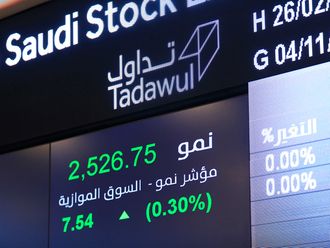Savvy foreign funds are pumping top dollars into Indian equities and bonds, unmindful of expensive valuation as they bet growth would pick up in the months ahead. The underlining theme is to look beyond expected mixed quarterly earnings.
The $2 trillion Indian economy, Asia’s third-largest after China and Japan, is expected to expand 7.2 per cent in the 2017-18 financial year that began on April 1, the International Monetary Fund said, adding growth could accelerate to eight per cent in the medium term. The Asian Development Bank projects India’s economy to rise 7.4 per cent in 2017-18 and 7.6 per cent in the following year.
Reforms, such as the scheduled roll-out of a Goods and Services Tax (GST) in July, which would make the subcontinent a common market and help eradicate a messy mix of local taxes, should pave the way for stronger growth as companies benefit from ease of doing business.
A government crackdown on the parallel economy, which some economists estimate at almost as large as the formal economy, is seen pushing more businesses to come clean and enable improved tax compliance. Overall, the quality of growth is expected to improve and provide an impetus to enhanced economic activity.
“India returned to fiscal consolidation in fiscal year 2016/17, supported by the near-elimination of fuel subsidies and enhanced targeting of social benefits, notwithstanding the deceleration in growth related to the country’s recent currency exchange initiative,” the IMF said.
Economists, at foreign and domestic banks and brokerages, had slashed India’s growth forecast by about one percentage point after Prime Minister Narendra Modi stunned the nation last November 8 by announcing to scrap high-value bank notes — which comprised 86 per cent of the currency in circulation — to fight unaccounted cash hoardings, counterfeit notes and terror funding.
The move had triggered a severe cash crunch over two months and caused shift shutdowns at factories as consumer spending took a hit. Inventories piled up at warehouses and dealt a blow to economic growth.
However, the situation has improved dramatically — better than expected — and the IMF, which had initially cut its growth forecast for India to 6.6 per cent in 2016-17 from 7.6 per cent projected earlier, has now revised it upwards to 6.8 per cent.
Good rains seen
Annual monsoon rains are a decisive factor for India’s economy and the initial report by the official forecaster, the India Meteorological Department, projects the four-month wet season starting June at 96 per cent of the 50-year average, with a margin of error of five per cent.
The IMD, which uses many parameters including surface temperatures of oceans, satellite images and cloud formation, defines normal monsoon at between 96 per cent and 104 per cent. Rains last year were normal after two consecutive years of below average rainfall and drought in many regions.
Private forecast Skymet Weather Services expects the June-September rains at 95 per cent this year, with chances of above-normal showers at 10 per cent and a 50 per cent chance of normal rainfall.
The annual rains are the main source of irrigation and are critical to 70 per cent of the population that depend upon farm-related activity for their livelihood. Good monsoon typically bolsters farm output, raises rural incomes and enhanced spending on a wide range of manufactured goods — from motorcycles and cars to home appliances and items of everyday use.
In a nation of more than 1.3 billion people, the spending by households makes a vital difference to the fortunes of companies. Little surprise fund managers are salivating at the prospect of another year of bountiful showers, which would mean improved sales and profits.
“The Indian economy is on the cusp of delivering growth at an accelerated pace driven by reforms, demographic dividends and consumption demand,” Arun Thukral, CEO of Axis Securities Ltd, wrote in an article in the Economic Times.
“As the economy picks up pace, consumption-led demand can lead to an improvement in capacity utilisation of the industry, thus boosting corporate bottom lines across industrial sectors. Identifying these opportunities and investing in them can help create wealth for an investor.”
The sectors to watch out are defence, textiles, auto and auto ancillaries, pharmaceuticals, information technology and its enables services, infrastructure-related, consumer goods, financial and insurance, he said.
The top-30 Sensex and the broader 50-share Nifty closed down 0.3 per cent each over the week on mixed earnings numbers, but the undercurrent was resilient and foreign demand was strong. Some fund managers believe that India is heading for a rating upgrade when growth picks up and the government gets a firmer handle on debt.
“Portfolio investors are early movers,” Dhiraj Relli, CEO of HDFC Securities, wrote in an article in the Economic Times. “By the time rating agencies put the stamp of approval on the improving economy, they would have made their money. “
Reliance, Maruti
Two stocks that would be on the focus in the coming week are energy conglomerate Reliance Industries Ltd and car maker Maruti Suzuki India Ltd.
Reliance, owner of the world’s largest refining complex in Jamnagar, Gujarat, has raised investor expectations after it signed up more than 100 million subscribers for its Jio mobile services since formal commercial launch last September. After offering the services, including calls, internet and TV channels, free for seven months, it began charging from April.
The company is scheduled to release its quarterly results on Monday and analysts are betting earnings per share would have risen by 8-9 per cent on improved petrochemical and refining margins. Brokerage CLSA expects earnings estimates for 2017-18 and 2018-19 could likely be upgraded.
Shares in Reliance have leapt by more than a quarter this year, and briefly topped the market capitalisation chart this week.
Maruti Suzuki, which makes every second new car sold in India, announces its March quarter earnings on Thursday. Brokerage Sharekhan expects its profit to jump 57.6 per cent from the same period a year earlier and up 2.4 per cent from the December quarter when earnings grew an annual 48 per cent.
The company is leading a boom in car sales, especially for bigger vehicles that give fatter margins. Shares in Maruti have gained 16.5 per cent this year at Rs6,203.60. The stock had climbed 15.3 per cent in 2016 and 38.7 per cent in 2015.
“We continue to prefer Maruti Suzuki in the automotive space, given the long waiting period on recent launches (Baleno, Vitara Brezza and Ignis). This would enable Maruti Suzuki to continue outpacing the passenger vehicle segment growth going forward,” Sharekhan said in a note.
Other big results UltraTech Cement, the country’s biggest maker of cement, on Monday; No. 3 software services exporter Wipro Ltd, Axis Bank, IDFC Bank, ICICI Prudential Life Insurance Company and on LIC Housing Finance on Tuesday; and Kotak Mahindra Bank and TVS Motor on Thursday.
Tata Consultancy
Results from Tata Consultancy Services, the leading software services company, brought some relief after the disappointment over Infosys the week before. Still, analysts were cautious on the outlook for the sector because of protectionist barriers coming up in the US, the industry’s biggest market.
“We are competitive and as long as the regimes are broadly equal for everyone we don’t see our relative competitiveness actually going down,” Chief Executive Rajesh Gopinathan, who took over the top job in February, told a news conference.
President Donald Trump this week ordered a review of the visa programme for bringing highly skilled workers into the United States, a facility used by companies such as TCS, Infosys and Wipro among others to run their outsourcing contracts at competitive pricing. Any restrictions on the recruitment of cheaper foreign labour could raise the costs of software services companies.
Consolidated net profit rose 4.2 per cent from a year earlier to Rs66.08 billion in the March quarter, missing market expectations, while revenue also grew at a similar pace to Rs296.42 billion.
“While we continue to repose faith in the medium term prospects of the company, TCS will need to achieve higher growth rates and maintain margins to sustain its premium valuations,” Kotak Securities wrote in a note.
The writer is a journalist based in India.












